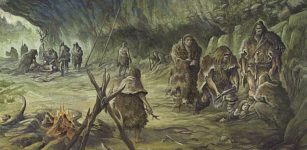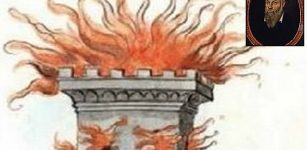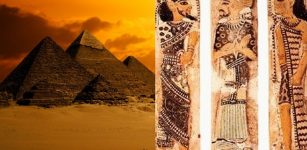Spells And Magic Were Important To Samurai Warriors And Used In Battles
Ellen Lloyd - AncientPages.com - Shamans, wizards, priests, and priestesses were not the only ones who depended on spells and magic in the ancient world.
Superstition played a major role in ancient Japanese warfare and the battles of the Samurai.
Honda Tadakatsu, also called Honda Heihachiro, was a Japanese samurai, general of the late Sengoku through early Edo periods, who served Tokugawa Ieyasu.
In his book, The Dark Side of Japan: Ancient Black Magic, Folklore, Ritual, Ninja researcher and historian Antony Cummins, investigates how and why the Samurai paid attention to supernatural creatures, spells, gods, goddesses, magic and anything that was of superstitious nature.
The Samurai who was considered a hero followed the Bushido Code, centuries-old unwritten code for ideal Samurai warrior.
It seems rather odd that a Samurai warrior who was courageous should engage in beliefs about supernatural creatures.
Some Samurai Warriors Believed In Evil Creatures
According to some ancient historical scrolls stating that some samurai did indeed believe in such creatures and to them, such evil was a reality, but yet there are other scrolls which say that samurai should ignore such trivial fantasies and should place them in the realm of “women, children and temple maidens”.

Yōkai haunt bridges and tunnels, entranceways and lurk and disturb at crossroads and thresholds; they are elsewhere, changing their forms and places.
In ancient Japan people used to believe that evil could be awakened in the strangest of places and demons and other mysterious beings were responsible for unlucky events.
One such creature was the Yōkai, a mysterious interdimensional being that dwell in the borderlands and in spaces, which are located “in-between”.
Juji - Ritual Practiced By Japanese Warriors To Dispel Evil
The Samurai believed in the existence of both benign as well as malign spirits. By praying to ancestors for help and use spells connected with gods and spirits, it was possible to ward off evil.
Juji, which means “ten signs” was practiced by Japanese warriors to dispel evil and to create positivity before they move into a certain situation.
The concept of the Juji ritual was widespread, in both samurai culture, medicine and shamanism.
Juji spells were taught in Samurai schools and the magic was not as secret as the samurai believed it to be and it does in fact pre-date the Samurai.
See also:
Sacred Regalia Of Japanese Emperor: Sword, Mirror And Jewel In Ancient Japanese Tradition
Towering Sacred Mt. Fuji: Abode Of The Immortals In Ancient Japanese Beliefs
Shinobi No Mono: The Shadow Warriors And Hattori ‘The Demon’ Hanzo Of Ancient Japan
Another spell often used by the Samurai was the Kuji. The Kuji spell was used to get rid of any tension before a samurai committed an assassination, to dispel the killing intent from their body before they killed a target. This was done so that the enemy would not ‘feel’ them coming.
By the year 1600, warfare changed and the Samurai did not depend as much on ‘magic’, but they did not fully forget their spells.
According to Cummins “large scale magical warfare had all but ended, with logic and practicality taking the lead in decisions made in combat, but ancient samurai schools did not forget their spells. Military study very much included the esoteric and the ritual, even if it was not put in to practice on the battlefield. However, the age of samurai at war was over by the 1600s and the land was under a single government, but even though war had all but finished, magic did not.
The Dark Side of Japan is a collection of folktales, ritual black magic, protection spells, monsters, and other dark interpretations of life and death from Japanese folklore. Most of the information comes from ancient documents, translated into English for the first time. Antony Cummins has also searched the now forgotten Victorian volumes on Japanese mythology and explains recent academic research on Japan for the non-expert.
Pulling all these strands together, Antony has reformed the complex information with these brand new translations into a modern rendering, with stories and details that let a modern reader enter into the world of the forgotten legends of old Japan and the superstitions that color them, some of which still exist today. The Dark Side of Japan is illustrated with more than 100 images, some drawn from ancient scrolls, some photographs of contemporary Japan, some specially commissioned to explain some of the "hellish" concepts within—and remarkably hellish they are, too. Read more:
Personal magic, religious magic and shamanism was active right up until the 20th century and even into pre-WWII Japan. It must be recognized that magic did decline in Japan but it did not end. High level magical rituals are still performed in Buddhism and the common people still have vestiges of a dying magic culture, even into the start of the 20th century some families were segregated from communities because they were bewitched and cursed bloodlines.
See also:
Seppuku: Ancient Suicide Ritual That Guaranteed Honorable Death Instead For Life In Shame
Samurai – Powerful Skilled Warriors Who Loved Music, Art And Poetry
Jigai – Suicide Ritual For Wives Of Samurai – Feminine Counterpart Of Seppuku
The Japanese will also try to choose the best dates to have children, they will attend ceremonies to attract luck, they observe many cultural customs that are direct decedents of these ancient magical forms and if you look around in modern Japan and if you know what you are looking for, you can still see this magic alive today.”
Written by - Ellen Lloyd - AncientPages.com
Copyright © AncientPages.com All rights reserved. This material may not be published, broadcast, rewritten or redistributed in whole or part without the express written permission of AncientPages.com
More From Ancient Pages
-
 Neanderthals Buried Their Dead – New Evidence
Archaeology | Dec 10, 2020
Neanderthals Buried Their Dead – New Evidence
Archaeology | Dec 10, 2020 -
 Jizo – Protector Of Children, Travelers And Women In Japanese Mythology
Featured Stories | Dec 23, 2015
Jizo – Protector Of Children, Travelers And Women In Japanese Mythology
Featured Stories | Dec 23, 2015 -
 Tarkhan Dress – The World’s Oldest Woven Garment
Archaeology | Feb 24, 2016
Tarkhan Dress – The World’s Oldest Woven Garment
Archaeology | Feb 24, 2016 -
 Terrifying Buggane: Demonic And Tyrannical Celtic Demon That Hated Churches And Set Them On Fire
Celtic Mythology | Jul 14, 2017
Terrifying Buggane: Demonic And Tyrannical Celtic Demon That Hated Churches And Set Them On Fire
Celtic Mythology | Jul 14, 2017 -
 Mayong – Mysterious Ancient Land Of Black Magic In India
Featured Stories | Mar 7, 2019
Mayong – Mysterious Ancient Land Of Black Magic In India
Featured Stories | Mar 7, 2019 -
 Has The Mystery Of Bronze Age Tin Been Solved?
Archaeology | Oct 3, 2019
Has The Mystery Of Bronze Age Tin Been Solved?
Archaeology | Oct 3, 2019 -
 Herculaneum Time Capsule: Ancient Scrolls With Secrets Buried Under Volcanic Ash And Stones
Civilizations | Aug 24, 2016
Herculaneum Time Capsule: Ancient Scrolls With Secrets Buried Under Volcanic Ash And Stones
Civilizations | Aug 24, 2016 -
 Rare Minoan Sealstone Is A Miniature Masterpiece Unearthed In 3,500-Year-Old Tomb Of Powerful Mycenaean Warrior
Archaeology | Nov 8, 2017
Rare Minoan Sealstone Is A Miniature Masterpiece Unearthed In 3,500-Year-Old Tomb Of Powerful Mycenaean Warrior
Archaeology | Nov 8, 2017 -
 Warrior King Eadberht Of Northumbria And A Four-Legged Beast Featured On Ancient Coin Discovered The Holy Island
Archaeology | Nov 11, 2021
Warrior King Eadberht Of Northumbria And A Four-Legged Beast Featured On Ancient Coin Discovered The Holy Island
Archaeology | Nov 11, 2021 -
 The Lost Prophecy Reveals Chilling Future Events – The Last Words To Mankind?
Featured Stories | Jan 24, 2015
The Lost Prophecy Reveals Chilling Future Events – The Last Words To Mankind?
Featured Stories | Jan 24, 2015 -
 Tomb Of Maia, Tutankhamun’s Wet Nurse In Egypt’s Saqqara Opens To Public
Archaeology | Dec 22, 2015
Tomb Of Maia, Tutankhamun’s Wet Nurse In Egypt’s Saqqara Opens To Public
Archaeology | Dec 22, 2015 -
 Mysterious Menga Dolmen: A New Very Old Monument Discovered
Archaeology | Sep 21, 2020
Mysterious Menga Dolmen: A New Very Old Monument Discovered
Archaeology | Sep 21, 2020 -
 Bacho Kiro Cave: Early Homo Sapiens Groups In Europe Faced Subarctic Climates
Archaeology | Sep 24, 2021
Bacho Kiro Cave: Early Homo Sapiens Groups In Europe Faced Subarctic Climates
Archaeology | Sep 24, 2021 -
 Templo Mayor – Sacred Aztec Complex Dedicated To Gods Tlaloc And Huitzilopochtli Who Were Usually Appeased With Human Sacrifices
Featured Stories | Jan 23, 2018
Templo Mayor – Sacred Aztec Complex Dedicated To Gods Tlaloc And Huitzilopochtli Who Were Usually Appeased With Human Sacrifices
Featured Stories | Jan 23, 2018 -
 British Museum Is World’s Largest Receiver Of Stolen Goods – Says QC
Archaeology | Nov 12, 2019
British Museum Is World’s Largest Receiver Of Stolen Goods – Says QC
Archaeology | Nov 12, 2019 -
 The Govan Stones – Treasures From The Viking Era In Britain
Featured Stories | Dec 27, 2015
The Govan Stones – Treasures From The Viking Era In Britain
Featured Stories | Dec 27, 2015 -
 Huge Ancient Animal Sculptures Made By Unknown Carvers At Camel Site In Saudi Arabia Puzzle Archaeologists
Archaeology | Feb 14, 2018
Huge Ancient Animal Sculptures Made By Unknown Carvers At Camel Site In Saudi Arabia Puzzle Archaeologists
Archaeology | Feb 14, 2018 -
 Ancient Roman Joke Inscribed On A 2,000-Year-Old Pen – Discovered
Archaeology | Jul 29, 2019
Ancient Roman Joke Inscribed On A 2,000-Year-Old Pen – Discovered
Archaeology | Jul 29, 2019 -
 Ancient Monastery In The Middle Of ‘Syria’s Stonehenge’ – Underground Caves, Tombs, Stone Circles Older Than Pyramids
Civilizations | Nov 13, 2015
Ancient Monastery In The Middle Of ‘Syria’s Stonehenge’ – Underground Caves, Tombs, Stone Circles Older Than Pyramids
Civilizations | Nov 13, 2015 -
 Mysterious Hyksos People Rose To Power In Ancient Egypt Through Marriage And Not Invasion – Researchers Say
Archaeology | Apr 17, 2019
Mysterious Hyksos People Rose To Power In Ancient Egypt Through Marriage And Not Invasion – Researchers Say
Archaeology | Apr 17, 2019



